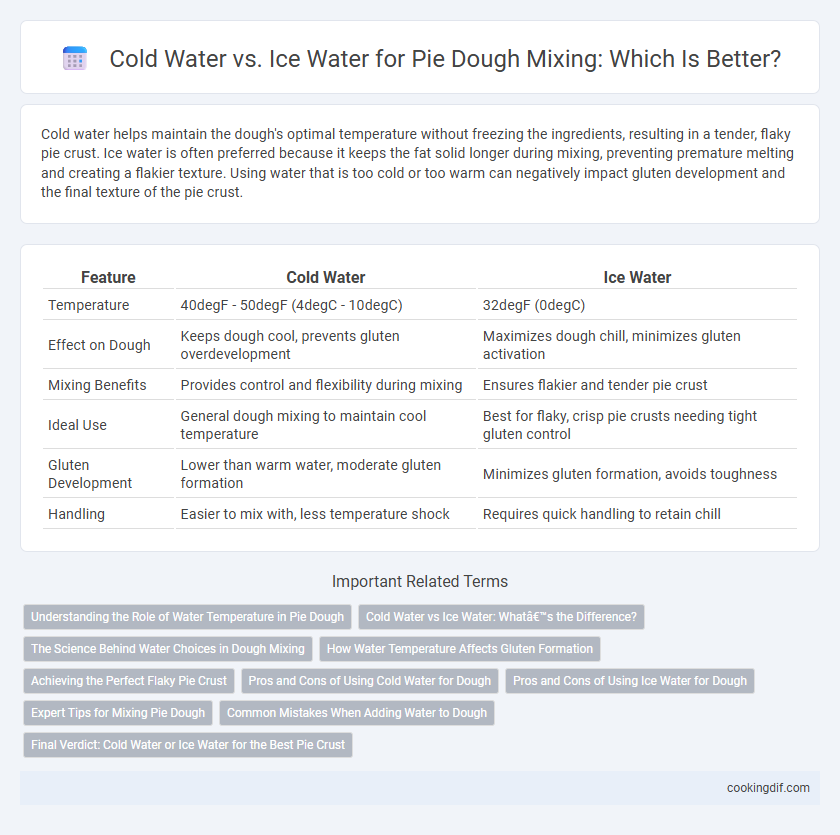Cold water helps maintain the dough's optimal temperature without freezing the ingredients, resulting in a tender, flaky pie crust. Ice water is often preferred because it keeps the fat solid longer during mixing, preventing premature melting and creating a flakier texture. Using water that is too cold or too warm can negatively impact gluten development and the final texture of the pie crust.
Table of Comparison
| Feature | Cold Water | Ice Water |
|---|---|---|
| Temperature | 40degF - 50degF (4degC - 10degC) | 32degF (0degC) |
| Effect on Dough | Keeps dough cool, prevents gluten overdevelopment | Maximizes dough chill, minimizes gluten activation |
| Mixing Benefits | Provides control and flexibility during mixing | Ensures flakier and tender pie crust |
| Ideal Use | General dough mixing to maintain cool temperature | Best for flaky, crisp pie crusts needing tight gluten control |
| Gluten Development | Lower than warm water, moderate gluten formation | Minimizes gluten formation, avoids toughness |
| Handling | Easier to mix with, less temperature shock | Requires quick handling to retain chill |
Understanding the Role of Water Temperature in Pie Dough
Cold water helps maintain the fat's solid state in pie dough, resulting in a flakier texture by creating distinct layers during baking. Ice water, being colder, ensures minimal gluten development by keeping the dough chilled, which prevents toughness and promotes tenderness. Using the proper water temperature is crucial for achieving optimal dough consistency and enhancing the final pie crust quality.
Cold Water vs Ice Water: What’s the Difference?
Cold water temperatures typically range from 50degF to 70degF and help slow gluten development in pie dough, resulting in a tender, flaky crust. Ice water, often around 32degF, further chills the fat (like butter or shortening) in the dough, preventing it from melting too quickly and creating distinct flaky layers. Using ice water is preferable for pie crusts requiring maximum flakiness and crispness, while cold water offers a balance between ease of mixing and texture.
The Science Behind Water Choices in Dough Mixing
Cold water slows yeast activity in dough mixing, promoting a longer fermentation that enhances flavor and texture by allowing gluten strands to develop more gradually. Ice water further reduces the dough temperature, crucial for pastries like pie crusts, as it prevents the butter from melting, resulting in flakier layers. The temperature of water directly influences enzymatic reactions and gluten development, making precise water temperature control essential for optimal dough consistency and pie quality.
How Water Temperature Affects Gluten Formation
Cold water slows gluten formation during dough mixing, resulting in a tender and flaky pie crust by preventing the proteins from developing too quickly. Ice water further inhibits gluten development, offering greater control over dough elasticity and ensuring a delicate texture. Using colder water helps maintain the pie dough's structure while avoiding toughness caused by overworked gluten strands.
Achieving the Perfect Flaky Pie Crust
Using cold water instead of ice water for mixing pie dough can impact gluten development and dough temperature control, crucial factors for achieving a flaky crust. Ice water helps maintain a cold dough environment, preventing butter from melting too quickly and ensuring distinct flaky layers. Optimal hydration with ice water combined with minimal handling results in a tender, crisp pie crust texture.
Pros and Cons of Using Cold Water for Dough
Cold water in dough mixing helps maintain a lower gluten development rate, resulting in a more tender and flakier pie crust. It slows yeast activity, preventing over-fermentation, which is essential for achieving the ideal texture and structure in pie dough. However, cold water can make the dough stiffer and harder to knead, requiring additional time to achieve the right consistency.
Pros and Cons of Using Ice Water for Dough
Ice water in pie dough mixing helps maintain a cold temperature, preventing the butter from melting and resulting in a flakier crust due to the steam created during baking. Using ice water can make the dough more difficult to knead and slow down gluten development, potentially affecting texture and rise. While ice water ensures optimal fat solidification and pastry tenderness, it may require more effort to achieve proper dough consistency compared to cold but not iced water.
Expert Tips for Mixing Pie Dough
Using cold water instead of ice water for mixing pie dough helps maintain optimal dough temperature, preventing the butter from melting prematurely and ensuring a flaky crust. Expert bakers recommend chilling the water to just above freezing, which effectively keeps the dough cold without causing ice crystals that could disrupt texture. Precise temperature control during mixing is essential for achieving the desired tenderness and flakiness in pie dough.
Common Mistakes When Adding Water to Dough
Using ice water instead of cold water can slow yeast activation, resulting in denser pie dough with less rise. Over-chilling dough by adding excessive ice water can cause gluten to tighten excessively, leading to a tough crust. Many bakers mistakenly use warm or room temperature water, which can cause premature fermentation and affect dough texture negatively.
Final Verdict: Cold Water or Ice Water for the Best Pie Crust
Ice water is ideal for pie crust dough mixing because it keeps the fat solid, resulting in a flakier texture by creating small pockets of steam during baking. Using cold water can work but risks warming the butter slightly, leading to a denser and less tender crust. For the best pie crust, always choose ice water to maintain optimal dough temperature and achieve superior flakiness.
Cold water vs Ice water for dough mixing Infographic

 cookingdif.com
cookingdif.com